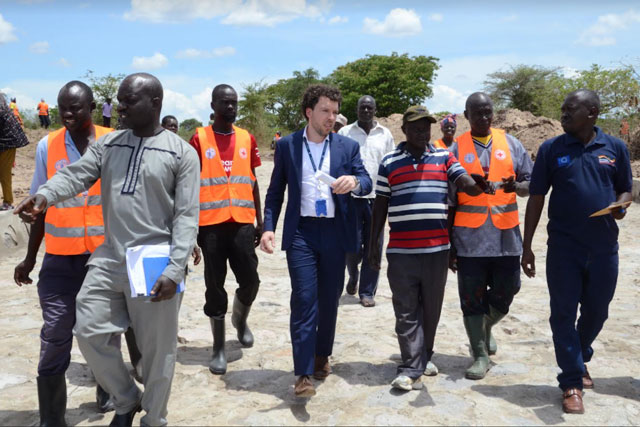
Katakwi, Uganda | PATRICIA AKANKWATSA | In a bid to safeguard food security and livelihoods in flood-prone areas of Uganda, the Food and Agriculture Organization of the United Nations (FAO) is implementing a project focused on early warning and anticipatory action.
With a specific focus on vulnerable communities residing in flood hotspots, the initiative aims to minimise potential losses caused by the anticipated flooding season. This comprehensive initiative combines proactive measures focused on early warning and anticipatory action for communities with tangible improvements to critical infrastructure.
FAO’s intervention is a Belgian-funded project titled “Strengthening flood early warning, preparedness and Anticipatory Action in hot-spot areas.” This initiative equips vulnerable households with the tools and knowledge they need to take proactive measures before the floods hit.
While speaking at the handover of the rehabilitated projects in Katakwi, Dominique Reumkens the Programme Specialist Commissioning project works at FAO, said that the implemented actions contributed to the resilience of food production and livelihood systems for food and nutrition security in the targeted areas.
“The nature of the works we are handing over today fit within FAO corporate strategic framework of the four betters: better production, better nutrition, a better environment, and a better life, leaving no one behind,”
“FAO remains committed – in collaboration with key stakeholders such as the Uganda Red Cross Society to supporting the Government of Uganda and communities to plan for and manage future hazards, both the foreseeable and the unforeseeable, in the Teso Sub-Region as well as in other disaster-prone areas of Uganda,”
FAO completed the rehabilitation of the Ocorimongin market, a hub for livestock and foodstuffs in the Teso region. Previously, this marketplace was susceptible to flooding, disrupting trade and threatening the food supply chain.
This initiative ensures continued market activity even during heavy rains, safeguarding a cornerstone of the region’s food security. A functional Ocorimongin market not only allows farmers to sell their produce but also ensures residents have uninterrupted access to essential food supplies.
Another crucial aspect of the FAO’s intervention is the rehabilitation of the Cheele Dam. Alongside the market improvement initiative, this project strengthens Katakwi’s capacity for effective water resource management.
A functional Cheele dam offers a multitude of benefits. It provides a reliable source of water for irrigation and livestock during dry periods, promoting agricultural productivity and supporting livelihoods.
“Our animals used to die because of lack of water but with FAO’s intervention, we have hope of developing our animals. We used to move long distances to look for water,” John Emmanuel Akori one of the cattle keepers.
He added that with a reliable water source, they can be able to keep the good cattle breeds that are more profitable.
More importantly, a well-maintained dam can also help regulate water flow during floods, potentially mitigating their severity by capturing excess rainwater and releasing it gradually.
Beyond warnings, the FAO is equipping households with the knowledge and tools needed to prepare. This is being done in partnership with the Uganda Red Cross.
Mark Ebulu the branch manager of the Uganda Red Cross in Katakwi said that 348000 people in four districts received post-harvesting materials and 651 people out of 680 were paid to work on the rehabilitation project.
Emmanuel Okwii one of the beneficiaries said that working on the rehabilitation projects with FAO was an eye-opener.
“Learning new skills to prepare for floods and being part of improving the market has given our community a sense of control and hope. We now feel more prepared to face the coming season and protect our homes, our crops, and our way of life,”
This multifaceted intervention underscores the FAO’s commitment to addressing both the immediate threats posed by floods and the long-term water resource challenges faced by the Katakwi community.
FAO provided support to 13,063 vulnerable farming households (78,375 people) between August 2023 and March 2024.
Uganda ranks 16 out of 191 countries in terms of risk, driven by the increasing frequency, intensity and scale of disasters affecting the country. Flooding is among the top hazards of drought, epidemics and earthquakes. Frequent and devastating flooding causes loss of life and livelihoods, displacement, property and environmental damage and disruption of essential services with health hazards. Floods in Uganda affect 50,000 people yearly and the costs of the impact amount to USD 62 million which is 0.13% of the GDP.
Various climate models and forecasts pointed towards a high likelihood of an El Niño occurrence in the last quarter (October-December) of 2023. In East Africa, including Uganda, El Niño was expected to cause enhanced rainfall and subsequent floods like in the case of 1997/98, 2002 and 2015. The El Niño floods in Uganda of 1997/98 and 2002 led to an estimated death of 1,000 people, displacement of 150,000 people damage to infrastructure, and inundation of crops with 60% drop in coffee export. Additionally, over 11,000 people were hospitalized needing cholera treatment.
 The Independent Uganda: You get the Truth we Pay the Price
The Independent Uganda: You get the Truth we Pay the Price



